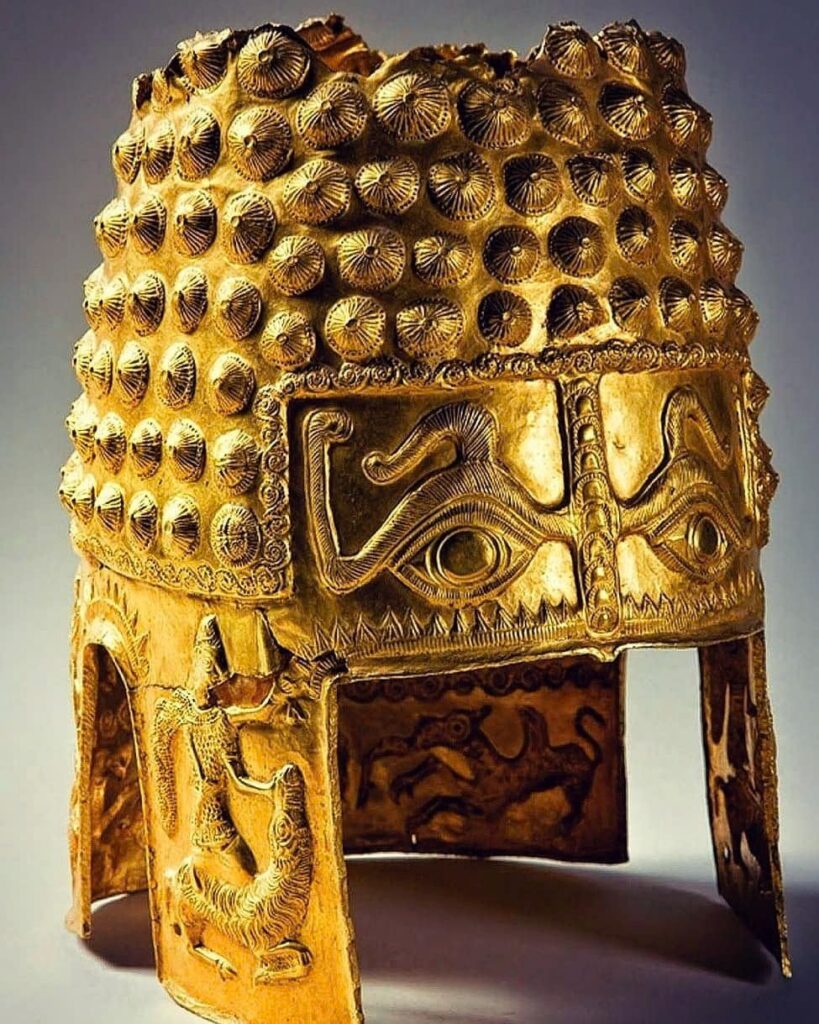Hidden in the heart of Romania for two millennia, an extraordinary artifact known as the Geto-Dacian ceremonial crown, or the Golden Helmet of Coțofenești, reveals the grandeur of an ancient civilization. This remarkable golden crown not only reflects the exceptional craftsmanship of its creators but also provides a fascinating glimpse into the cultural, spiritual, and political life of the Geto-Dacians, an influential people of ancient Europe.
Weighing an impressive 726 grams and standing at 25.5 centimeters in height, this magnificent crown is composed of 76% pure gold. Its intricate designs and symbolic imagery reflect a rich tapestry of beliefs and values that characterized the Geto-Dacian society. Every detail, from the craftsmanship to the choice of materials, offers insights into the spiritual and political dimensions of their world.

Adorned with symbolic motifs, the crown features winged creatures such as griffins, which were revered as sacred intermediaries between the earthly and divine realms. These mythical beings, often associated with power and protection, hint at the rulers’ spiritual aspirations and their connection to the divine. For the Geto-Dacians, such imagery reinforced the belief that their leaders were chosen by the gods, serving as a bridge between humanity and celestial powers.
Central to the crown’s design are depictions of ritual offerings to Zamolxis, the Geto-Dacian god of the underworld. This deity held a significant place in their spiritual hierarchy, symbolizing both life’s mysteries and the promise of renewal. Additionally, the crown’s artistry reflects the influence of Mithraism and celestial deities such as Apollo and Helios, highlighting the diversity of spiritual traditions that shaped Geto-Dacian beliefs. These depictions demonstrate how their faith was an intricate blend of local traditions and external influences, creating a multifaceted spiritual identity.
The crown was not merely a decorative object; it served as a powerful symbol of authority and unity. Worn by Geto-Dacian kings during key ceremonies, parades, and even in battle, the crown projected an image of divine right and earthly power. Its golden gleam and elaborate design conveyed the majesty of the ruler and reinforced their role as a unifying figure within the kingdom. This sacred object became a visual representation of the bond between the ruler and the divine, as well as a symbol of the people’s collective identity.
Beyond its ceremonial role, the crown’s design held profound symbolic meaning. The gold elements represented unity, prosperity, and the divine connection of the ruler, while the inclusion of silver components symbolized the kingdom’s fertile and prosperous regions. This interplay of metals emphasized the balance between earthly abundance and spiritual transcendence, encapsulating the harmony the Geto-Dacian leaders sought to achieve.
The exceptional craftsmanship of the Geto-Dacian ceremonial crown is a testament to the advanced skills of their goldsmiths. As the operators of the largest gold-producing facilities in ancient Europe, the Geto-Dacians established themselves as master artisans whose work left a lasting mark on the continent’s cultural heritage. Their ability to blend technical precision with profound symbolism showcases a deep understanding of both material and spiritual artistry.
This crown offers a window into the past, allowing us to connect with the hopes, beliefs, and artistic achievements of the Geto-Dacians. It reveals a society that valued not only the material wealth of gold but also its spiritual significance as a medium for expressing their connection to the divine. Through this artifact, we gain insight into their worldview—a perspective shaped by the interplay of faith, power, and art.
The legacy of the Geto-Dacians is evident in the crown’s intricate details and the cultural richness it represents. It reminds us of the enduring human desire to express our deepest values and our relationship with the divine through art. As we marvel at the craftsmanship of this golden masterpiece, we are transported back in time to an era when art was not merely decorative but also deeply symbolic and integral to societal identity.
Today, the Golden Helmet of Coțofenești continues to captivate and inspire those who encounter it. Its beauty and historical significance serve as a bridge between the ancient and modern worlds, reminding us of the timeless connection between humanity’s spiritual aspirations and artistic expression. By studying this remarkable artifact, we honor the legacy of the Geto-Dacians and gain a deeper appreciation for the cultural foundations that helped shape Europe’s artistic and spiritual traditions.





